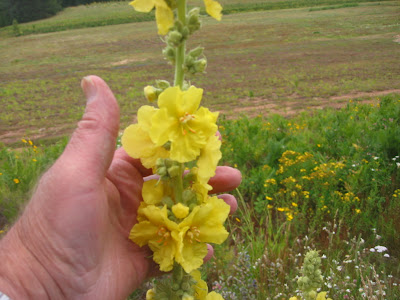


Monday, 7:15 AM. 56 degrees, wind W, calm. The channel is glassy with patterned dimpled areas. The sky is blue with some haze, and the barometer predicts mostly sunny skies.
The common, or great mullein, Verbascum thaspis, in the Scrophularia family, is a common plant of roadsides and fields, and is often considered a farm field weed. It is uncommonly prolific and beautiful in flower. It is a biennial, the first year’s growth being a flat rosette of fuzzy gray-green leaves, and the second year it shoots up a tall, rigid flower stalk, sometimes branched, which gives it another common name, “candles.” It is native to Eurasia and North Africa, and is much grown in gardens, particularly in England, where it has many horticultural varieties. It has many uses in herbal medicine, as it is strongly antiseptic, and before modern antibiotics was much used in the treatment of the coughs caused by tuberculosis (consumption). Oil of mullein is still used as a treatment for children’s ear problems. I use the hairy leaves as a poultice for skin infections caused by cuts, splinters, boils, etc. But the main virtue of mullein is its roadside beauty. Birds love the hard little seeds.


